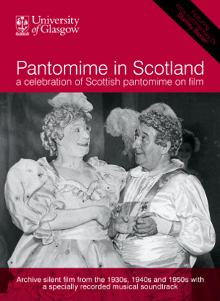Pantomime in Scotland: a celebration of Scottish pantomime on film 2010. GB. DVD. 165 minutes. University of Glasgow / Scottish Screen. Price: £18.95 (+ p&p). Available from: www.universityofglasgowshops.com/
 About the reviewer: Dr Alexandra Smith in Reader in Russian Studies at the University of Edinburgh. 'Prior to coming to the University of Edinburgh in January 2007, I taught at the University of Sheffield; University of Canterbury, New Zealand; University of Bristol and the University of Essex. I also worked for BBC2 and Channel 4 as a researcher and translator. I am a member of the editorial and advisory boards of several journals, including New Zealand Slavonic Review, Australian East European and Slavonic Studies, The Dostoevsky Journal: An Independent Review, Experimental Poetics and Aesthetics, and AvtobiographiIA (University of Padua). I'm also a member of the Editorial Board of the series Edinburgh Critical Studies in Modernism, Drama and Performance published by Edinburgh University Press. In addition to my research work and teaching, I also enjoy writing poetry, photography, translating literary and media texts, listening to classical and jazz music, visiting museums, travelling and reading books on history of ideas, performance, film, European cultural history and art history.'
About the reviewer: Dr Alexandra Smith in Reader in Russian Studies at the University of Edinburgh. 'Prior to coming to the University of Edinburgh in January 2007, I taught at the University of Sheffield; University of Canterbury, New Zealand; University of Bristol and the University of Essex. I also worked for BBC2 and Channel 4 as a researcher and translator. I am a member of the editorial and advisory boards of several journals, including New Zealand Slavonic Review, Australian East European and Slavonic Studies, The Dostoevsky Journal: An Independent Review, Experimental Poetics and Aesthetics, and AvtobiographiIA (University of Padua). I'm also a member of the Editorial Board of the series Edinburgh Critical Studies in Modernism, Drama and Performance published by Edinburgh University Press. In addition to my research work and teaching, I also enjoy writing poetry, photography, translating literary and media texts, listening to classical and jazz music, visiting museums, travelling and reading books on history of ideas, performance, film, European cultural history and art history.'
Pantomime, an essentially British concept, has existed as an independent genre for 300 years: John Rich, best-known for his staging of John Gay's The Beggar's Opera, receives the credit for introducing an entertainment which he coined ‘pantomime’ at the Lincoln's Inn Fields Theatre in London early in the 18th century. Theatre critics usually identify fall 1723 as the moment when pantomime emerged as a dominant theatrical form. Around the middle of the century the Grimaldi family arrived in England and Joe Grimaldi became the greatest clown of the time. Although pantomime had been influenced by the Commedia dell’ Arte, it drifted out in the Harlequinade and was retained as an unrelated after-piece. It disappeared shortly after World War I but was revived in the 1920s. 20th century children enjoyed knockabout comedians within the context of the loose plot of the pantomime, especially because of its use of broad visual humour and topical gags. Traditionally the setting for the finale includes a staircase for the walk-down, much light and glitter. Pantomimes must have children, with whom the youngsters in the audience identify. Clarity and projection are also vital in pantomime to ensure that children understand the story aurally as well as visually. The introduction of technology in the 1920s-30s adds distinctive cinematic quality to this form of entertainment that brings together dancing, acting and singing.
 The DVD featuring pantomime in Scotland in the 1930s-50s boasts a remarkable compilation of several silent films of popular pantomimes (performed in Edinburgh and Glasgow) taken from three collections held by the National Library of Scotland. They were created by two star comedians and one impresario who were amateur film makers working with the equipment available to them. Despite some technical drawbacks related to lighting and camera stability, all the films vividly convey the vibrant and exuberant atmosphere of the live performance. The films taken from the 'Horace Collins Films' collection for the DVD include five productions: The Forty Thieves (1931), Babes In The Wood (1936), Sinbad The Sailor (1936), The Forty Thieves (1937) and The Queen of Hearts (1937). They feature Fred Collins, who was a Glasgow-born comedian and the founder of the company, who in some pantomimes successfully parodies Stan Laurel. The film footage was produced by Collins’s son, Horace (1901-1947).
The DVD featuring pantomime in Scotland in the 1930s-50s boasts a remarkable compilation of several silent films of popular pantomimes (performed in Edinburgh and Glasgow) taken from three collections held by the National Library of Scotland. They were created by two star comedians and one impresario who were amateur film makers working with the equipment available to them. Despite some technical drawbacks related to lighting and camera stability, all the films vividly convey the vibrant and exuberant atmosphere of the live performance. The films taken from the 'Horace Collins Films' collection for the DVD include five productions: The Forty Thieves (1931), Babes In The Wood (1936), Sinbad The Sailor (1936), The Forty Thieves (1937) and The Queen of Hearts (1937). They feature Fred Collins, who was a Glasgow-born comedian and the founder of the company, who in some pantomimes successfully parodies Stan Laurel. The film footage was produced by Collins’s son, Horace (1901-1947).
All the films from this collection give excellent insight into the pantomimes’ colourful sets and create a unique opportunity to contemporary viewers to assess the talent of famous performers of the period, including comedians Dave Willis, Bert Denver and Harry Gordon, as well as star music hall singer Florrie Forde. Although The Forty Thieves was shot in black and white, most of the films were produced with the help of 16mm colour stock that allowedr viewers to better enjoy the visual effects and the splendour of the company’s set designs. The second collection comprises the excerpts from pantomimes staged at Glasgow’s Royal Princess’s’s Theatre —Tammie Twister (1933), Tammie Shanter (1934), Tammie Toddlers (1935) and Georgie Porgie (1940) — filmed by the popular comedian George West (1890–1963). Georgie Porgie exemplifies the visual extravaganza of the Princess’s pantomimes at its best: it features West and Jack E. Raymond involved in an imaginary time travel adventure that takes them from African jungles to Cleopatra’s Egypt toand ancient Venice with Roman gladiators, as well as a Glasgow train station milk bar serving alcoholic drinks. The unique blending of elements of the fantastic and the absurd featured in the films, together with the spectacular chorus numbers and the Thompson Sisters tap-dancing duo’s performances, invokes the romantic style that characterised Hollywood’s golden age of film composition from the mid-1930s to the 1950s.
Harry Gordon’s films are represented by coverage of the Alladin (1938) and Cinderella (1950) productions performed by Alhambra Theatre Glasgow. The ever-lasting popularity of Cinderella shows how the rowdy, bawdy, and satirical stage genre of British pantomime serves as an important medium for the transmission of fairy tales.
... a unique opportunity to contemporary viewers to assess the talent of famous performers of the period
Although the original films recordings were silent, a musical soundtrack of orchestral recordings of pantomime music of the 1920s and 30s has been created for the DVD. Together with new improvised piano music commissioned from Dave Anderson and Karen MacIver., The performance by the Orchestra of the Scottish Opera’s performance of music by Robert W. McLeod (1885-1962) bring to life the vibrant and colourful images of the past. Robert W.McLeod worked as Musical Director of the Princess’s Theatre in Glasgow from 1913 totill 1945, and thehis music he composed for pantomimes adds a sense of authenticity to these extraordinary recordings that capture the spirit of pantomime so well. The DVD package also comprises a 1927 sound film of Scottish comedian Tommy Lorne and a cinema trailer for Tartan Galore shown at the Metropolitan Theatre Glasgow in 1934.
While celebrating the incredible vigour and originality of Scottish pantomime in the 1930s, 40s and 50s, the DVD also draws the viewers’ attention to the specifics of late modern culture shaped by the privatisation of artistic production and consumption. With the rise of the printed book, modern literature became a storable treasure but lost its direct and live connection with the audience. The amateur Scottish filmmakers featured here managed to avoid the fate of modern novels by preserving the immediacy and authentic spontaneity of pantomime for future generations. The result is a real gem that will be undoubtedly enjoyed by students, scholars and everyone interested in Scottish modernist culture.
Alexandra Smith
For details of the University of Glasgow's Pantomime in Scotland project, click here.